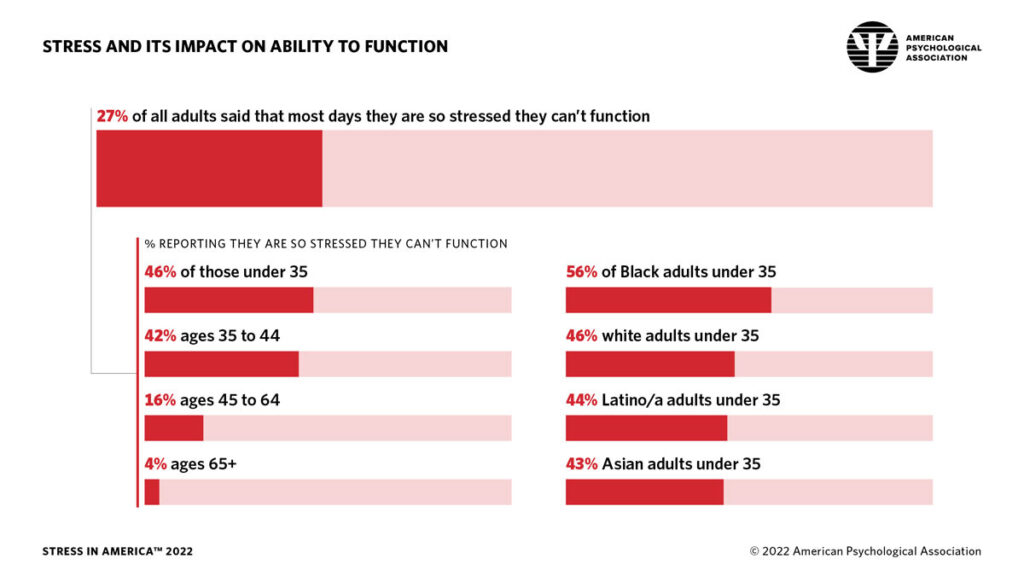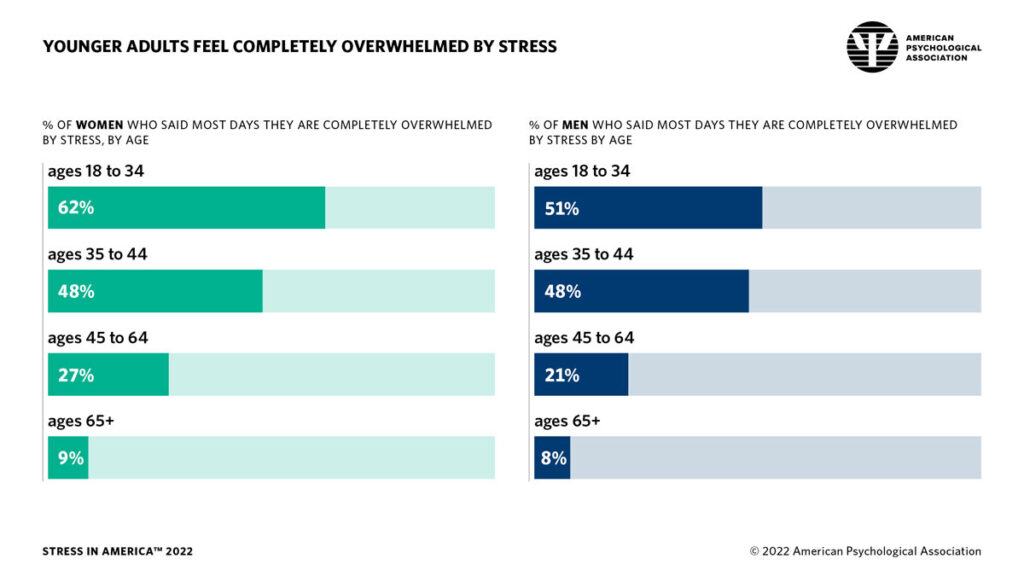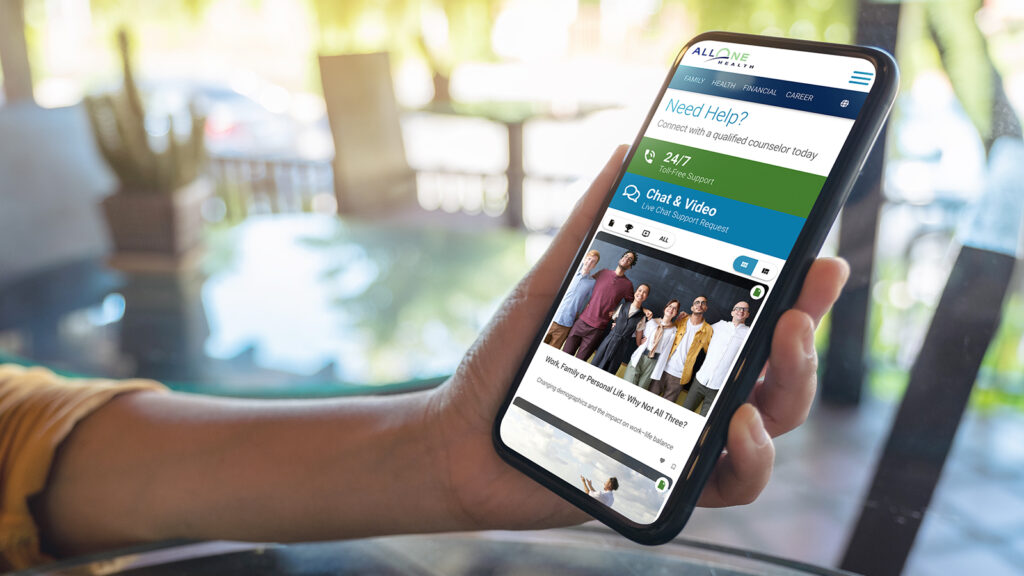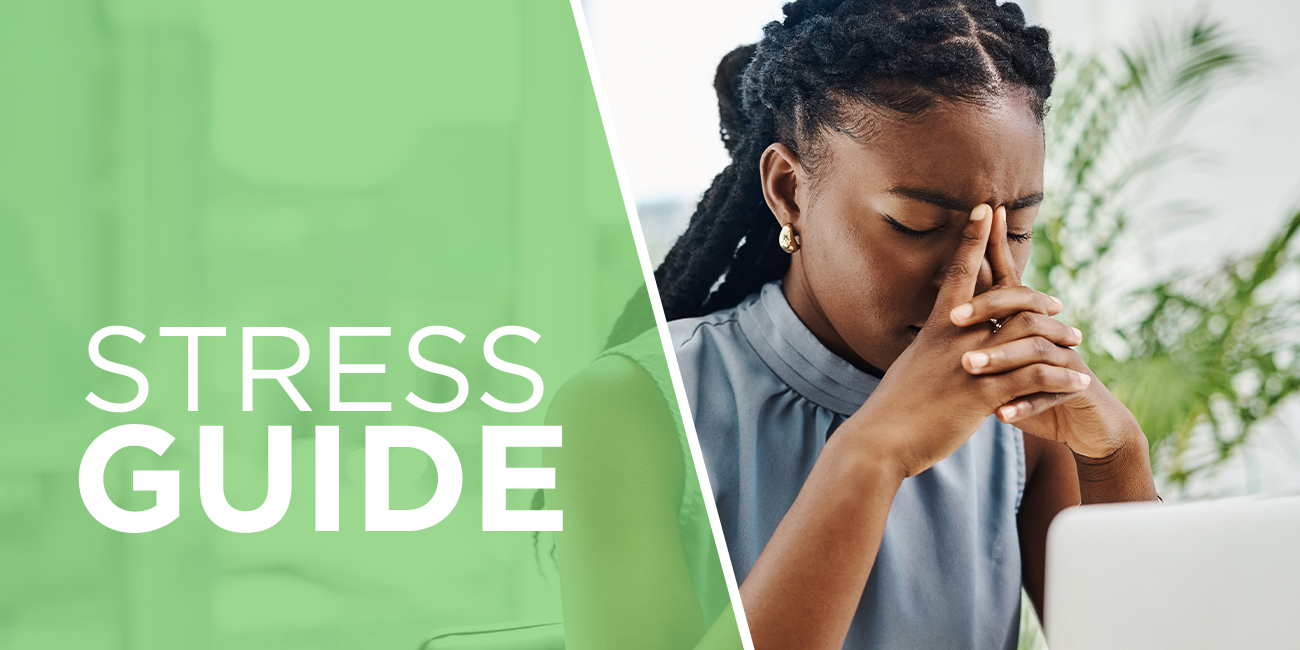Included in this guide:
- How the body responds to stress
- Leading sources of stress today
- How stress impacts health and behaviors
- Tips for managing stress
- How EAPs help organizations and people manage stress
What Is Stress?
Stress is the feeling of emotional or mental tension. It’s caused by any situations that are perceived as demanding or upsetting or make you feel frustrated, anxious, or nervous.
While stress is a normal reaction to everyday challenges, it can become a problem when it interferes with daily life.
Our stress response is wired into our DNA. It’s often referred to as our “fight, flight, or freeze” response.
Whenever we perceive or experience any threat, danger, or other type of stress, our body automatically releases the stress hormones cortisol and adrenaline. These hormones then trigger various physical and psychological responses that influence how we think, feel, and act.
Not All Stress Is the Same
Stress falls on a spectrum, ranging from mild to severe. It can also be short-term, intermittent, and long-term:
- Short-term stress, also known as acute stress, is brief and motivates us to take action due to an imminent threat or challenge. Examples include public speaking, running late for an appointment, or a near-miss car accident. Once the stressful incident is over, our hormone levels return to normal.
- Intermittent stress refers to stressors that occur periodically or fluctuate. Examples include recurring relationship issues, work deadlines, or major life changes.
- Long-term stress is also known as chronic stress. Examples include unending financial struggles, unrelenting job stress, living with a chronic health condition, or overwhelming work-life responsibilities.
Leading Sources of Stress in America
Every year since 2007, the American Psychological Association (APA) has commissioned a survey titled “Stress in America.” The survey provides key statistics for understanding and identifying the leading sources of stress.
From 2008 to 2012, the survey discovered that the top four stressors remained the same: money, work, family responsibilities, and health concerns.
A decade later, the APA found an entirely different list of stressors, which are outlined in the chart below and discussed in greater detail in the press release, Stress in America 2022.
THE TOP SOURCES OF STRESS IN AMERICA
Source: Stress in America 2022
2008-2012
Money
Work
Family Responsibilities
Health Concerns
2022
Inflation
Violence and Crime
Political Climate
Racial Climate
The 2022 survey also revealed that “27% of U.S. adults are so stressed most days they can’t function … disheartened by government and political divisiveness, daunted by historical inflation levels, and dismayed by widespread violence.”
Who Does Stress Impact the Most?
Here’s a closer look at those who are experiencing so much stress they cannot function:

The 2022 survey also revealed that young people, especially women, experience stress disproportionally.

As of 2022, research by The American Institute of Stress found that the current stress level experienced by Americans is 20 percentage points higher than the global average.
The Harmful Impact of Long-term Stress
Since prehistoric times, our stress response has been an important mechanism for helping us survive short-term stressors.
However, much of today’s stress is chronic stress, which causes our stress hormones to remain elevated. Over time, chronically elevated hormone levels can negatively impact our physical health, mental health, and behaviors.
IMPACT ON OUR PHYSICAL HEALTH
- Cardiovascular system: Chronically elevated stress hormones can increase our heart rate and blood pressure, which can lead to a higher risk of heart disease and stroke.
- Immune system: Chronic stress can weaken the immune system, making us more vulnerable to infections and illnesses.
- Digestive system: Stress can trigger digestive problems such as stomach pain, bloating, diarrhea, and constipation.
- Musculoskeletal system: Stress can cause muscle tension, headaches, migraines, and fatigue.
IMPACT ON OUR MENTAL HEALTH
Ongoing and recurring stress can trigger a variety of mental health conditions, including;
- Anxiety: Often caused by ongoing feelings of nervousness, fear, and worry.
- Depression: Frequently triggered by long-term sadness, hopelessness, and low mood.
- Post-traumatic stress disorder (PTSD): Frequently the result of being exposed to natural disasters, accidents, or violence.
- Burnout: This is a state of emotional, physical, and mental exhaustion caused by prolonged chronic stress.

IMPACT ON OUR BEHAVIORS
Both short-term and long-term stress can negatively impact our thoughts, emotions, and behaviors. Here are some examples of how stress affects our behaviors:
- Disrupted eating habits: Some people may overeat or turn to comfort foods when stressed. Others may lose their appetite or interest in food.
- Disrupted sleeping habits: Some people may stay up too late or have trouble falling asleep or staying asleep. Others may sleep too much.
- Substance misuse: Some people may misuse drugs or alcohol as a coping mechanism, which can lead to substance use disorders.
- Procrastination: Stress can make it difficult to focus, causing some people to avoid starting a stressful project.
- Reduced emotional control: When people feel stressed, they often become more irritable and lose their temper and patience more easily.
- Social withdrawal: Some people cope with stress by isolating themselves.
- Poor work performance: Stress can lead to poor work performance, increased absenteeism, and burnout.
Tips for Reducing Stress and Its Impact
Although today’s leading sources of stress are beyond our personal control, there are many things individuals and organizations can do to manage stress and its negative impact.
WHAT INDIVIDUALS CAN DO
- Accept that life has uncertainties. It’s helpful to focus on what remains within our control, whatever the circumstances.
- Disrupt negative thinking. Avoid ruminating on the past or worrying about potential consequences. If you find yourself spiraling into negative thinking or worst-case scenarios, focus instead on the best possible outcome and what you can do to make that happen.
- Take action. Voting, volunteering, and community involvement are meaningful activities that can help relieve stress and improve a stressful situation.
- Don’t judge yourself against others. Some people are better at dealing with life’s uncertainties and challenges. Be patient with yourself and others.
- Don’t look for a rescuer. Instead, seek out emotionally supportive friends and family who see you as capable and can help you focus on the next steps for managing and improving your situation. Asking someone else to solve the problem perpetuates the feeling that you are powerless or inadequate.
- Exercise. Physical activity releases endorphins, which are mood-boosting brain chemicals. Routine physical activity can also promote quality sleep, and ward off potential health problems.
- Practice relaxation techniques. Deep breathing, meditation, and yoga help reduce stress, promote relaxation, decrease anxiety, and improve your mood.
- Get enough sleep. Establish a consistent sleep schedule and aim for 7 – 9 hours of sleep each night.
- Eat a healthy diet. Try to eat a variety of nutrient-dense foods, such as fruits, vegetables, whole grains, lean proteins, and healthy fats.
- Take breaks. To help manage work stress, incorporate regular breaks throughout the day, such as going for a walk, practicing deep breathing, or listening to calming music.
- Talk with friends and family. Those who know you can be a sympathetic and supportive listener and provide helpful information and emotional support.
- Seek professional support if needed. Find out whether your employer offers an employee assistance program.
WHAT ORGANIZATIONS CAN DO
- Promote work-life balance. Encourage employees to take breaks, use vacation time and create healthy boundaries. It can also help to offer flexible hours and telecommuting options when possible.
- Provide supportive resources. Providing access to wellness services and workshops can help employees develop healthy habits that support stress management.
- Create a healthy work environment. Foster collaboration, respect, and open communication. Recognize people’s contributions and hard work.
- Address workload issues. Evaluate workload demands and help employees manage workloads effectively. Where appropriate, redistribute the workload or provide training programs and additional resources.
- Provide supportive benefits. An employee assistance program (EAP) offers information, resources, and referrals to help employees effectively address sources of stress.
How EAPs Support Individuals and Organizations
An employee assistance program (EAP) is a workplace benefit that is designed to help employees address everyday challenges that could have a negative impact on work or life.
EAPs provide counseling services for mental health issues and information and referrals to help manage work-life challenges.
Employee assistance programs also support organizational health by offering professional development and training programs to improve company culture and organizational success.
When employees have the support they need for managing life’s challenges, organizations are more likely to have an engaged and productive workforce.
When organizations, HR departments, and leadership teams have the support they need, they are more likely to experience improved performance and greater success.
How EAPs Work
While an employee assistance program is a benefit provided by the employer, its services are administered by a third party. Any personal information an employee shares with EAP providers remains private and confidential, following HIPAA privacy rules and federal regulations.
Employee assistance programs can help employees address mental health issues, legal issues, financial issues, and work-life responsibilities.
Many employee assistance programs also provide training programs and organizational development, and some EAP providers offer crisis management.
The AllOne Health Difference
Having been in the business of care for more than 50 years, AllOne Health fully understands that mental health remains one of the most critical issues of our time.
At the same time, we also recognize that mental health, physical health, and behaviors are all intertwined, and they’re greatly influenced by relationships, surroundings, workplace culture, and other life challenges.
Your One Solution for Whole Health
To meet the needs of today’s employees, AllOne Health has expanded its employee assistance programs to provide a whole health approach to benefits, with services that address:
- Mental health, with access to counseling services, life coaching, and in-the-moment support.
- Physical health, with access to medical advocacy, mindfulness tools, and an online well-being platform.
- Financial wellness, with access to financial consultation, legal consultation, training, and online tools.
- Family care, with access to comprehensive caregiving and work-life referrals.
- Lifestyle support, with access to personal assistant referrals.
- Organizational health, with access to management referrals, HR consultations, training, and crisis support.
Employees Can Request Services 3 Different Ways

Call
Employees can call their EAP 24/7/365 and speak with a real human being.

Live Chat
Employees can access the live chat from the EAP portal Monday through Friday, 8 am to 5 pm ET. If an employee is in crisis, they will be referred to in-the-moment counseling provided over the phone.

Online Request Form
Employees can request services from the EAP portal. They have the option of requesting mental health counseling or work-life resources and referrals.
Human Connection, Available 24/7/365
Employees can call their employee assistance program any time, day or night, weekends and holidays, and reach a real human being who is ready to listen and prepared to provide guidance and support.
If a call requires immediate attention, intake specialists will instantly connect the caller to a master’s level clinician, who can provide in-the-moment counseling services, which usually involve compassionate listening, sharing de-escalation techniques and coping strategies, and determining the appropriate next steps to address the employee’s needs.
In most cases, callers work with an intake specialist, who will ask a series of questions and then refer the caller for short-term mental health sessions or some other solution-focused counseling, such as a legal or financial consultant or a work-life specialist.
EAP Member Portal Resources
The EAP member portal and progressive web app serve as a whole health platform, connecting employees to online resources for mental health, wellness, stress management, substance misuse problems, mental health resources, and work-life challenges.
Information is categorized by the following topics: family, health, finances, career, living, military, and college. Employees can access self-service tools and materials, including thousands of articles, videos, worksheets, surveys, health and lifestyle assessments, interactive checklists, online learning programs, and shopping discounts.

The Benefits of Expanded EAP Services
We know that mental health, physical health, and behaviors are all intertwined, and they’re influenced by relationships, work, surroundings, and other aspects of life. To address these needs, AllOne Health brings a whole health approach to EAP programs, with expanded services to address what’s most important right now:
Short-term Counseling Sessions
Mental health therapy sessions can help employees and their family members manage stress, anxiety, grief, and depression, resolve conflict, improve relationships, overcome personal problems related to substance misuse, and address everyday challenges that interfere with work-life balance.
When an employee is overwhelmed by personal or work-related stress, they can’t perform their duties effectively. This can lead to decreased productivity, increased absences, safety issues, accidents, and perhaps workers’ compensation.
By supporting mental wellness, everyone benefits. Stronger employees lead to stronger families and stronger organizations while reducing workplace stress and employee turnover.
Life Coaching
A life coach has training in helping people achieve more by forming healthy habits, learning new skills, and tapping into self-motivation and accountability.
With the guidance of a life coach, employees can reach new goals, manage life transitions, and improve stress, time management, and overall mental wellness.
Coaching can also help employees succeed in intangible ways by helping them strengthen relationships, increase self-esteem, improve work-life balance, and live a more purposeful life.
Life coaching can eventually impact organizational health by promoting employee engagement, improving job performance, and enhancing company culture, which, in turn, can increase employee well-being and ROI.
Financial Consultations
Left unaddressed, financial stress can negatively impact mental health, physical health, and overall well-being. A certified financial counselor can provide budget coaching, financial planning, and consultations on bankruptcy, homebuying, debt management, taxes, identity theft, retirement planning, and saving for college.
When employees have the support they need to resolve financial concerns, they’re also more likely to improve their overall health and mental wellness.
Legal Consultations
Employees can connect with a qualified attorney for a consultation on personal legal matters, such as estate planning, wills, real estate, bankruptcy, divorce, custody agreements, eldercare, and adoption, helping them improve their outcomes on legal and family issues.
Work-life Resources and Referrals
By connecting with a work-life specialist, employees can receive resources and referrals for childcare, eldercare, pet care, and adoption. They can also receive special needs support, including referrals for education, enrichment activities, housing, transportation, and community resources.
When juggling work-related issues and family responsibilities, these EAP benefits can help employees with stress management and better work-life balance.
Medical Advocacy
A medical social worker has specialized training to help employees navigate through the healthcare system and understand health plans. This professional can determine what is included in a benefits package or health insurance plan, explain claims and coverage, and secure doctor referrals, medical equipment, transportation, and options for transitional care or discharge.
Organizational Health
AllOne Health employee assistance programs include employer services to support human resources and leadership teams, including unlimited telephone consultations with their account managers.
Account managers play an important role in helping workplace leaders understand when to make “informal” and “formal” referrals:
- An informal referral is a casual reminder that the employee assistance program is here to help.
- A formal referral is when a manager directs someone to seek a referral, often due to behavioral problems, performance issues, or a violation of workplace policies.
Account managers can also arrange training programs to support employees and leadership teams. The training programs discuss work-life balance, caregiving, adjusting to change, improving communication, overcoming compassion fatigue and burnout, navigating conflict, and promoting diversity.
Account managers can also help organizations by providing a Critical Incident Response (CIR) or a Critical Incident Stress Debriefing (CISD). These critical response services can help organizations and employees cope with natural disasters, an employee illness or death, workplace violence, layoffs, or other traumatic events that impact the workplace.
AllOne Health also offers expanded Organizational Development solutions for Diversity, Equity, Inclusion (DEI), Executive Coaching, Leadership Development, Group Work & Team Development, Change Management, and Organizational and Cultural Assessment.
Now What?
The best tool for managing stress is to have reliable support. AllOne Health is your one solution for whole health, providing a whole new approach to well-being.
Strengthen mental health. Beat burnout. Build financial wellness. Create Safe, inclusive environments. Keep everyone engaged. Grown stronger.
AllOne Health is here to help with a whole health approach to benefits, for what matters most right now.


